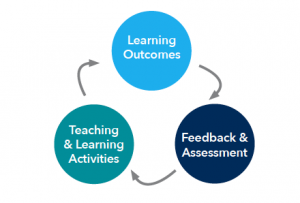Syllabus and Lesson Design
INTEGRATED COURSE DESIGN
Designing a new course can be a bit like putting together a piece of furniture. You have all the parts and there are instructions, but somehow you miss something and end up with a wobbly table. If you had it to do over again, you would easily get it right. The difficulties of setting up a new course are very common and educational developers have written advice on how to make this process easier and aligned with your own teaching goals. Drawing on course design literature, we will outline three parts of integrated course planning: 1) situational factors, 2) key components of course design, and 3) course alignment.
Situational Factors: To plan a thoughtful, student-centred course, it is helpful to start by examining the situational factors; this offers you a chance to think deeply about your course from both a teacher’s and a student’s perspective. D. Fink’s “A Self-Directed Guide to Designing Courses for Significant Learning,” page 7 has helpful worksheet to get you started. These factors help you better gauge how to plan your course and what to expect from your students. The first set of factors (“specific context of the teaching and learning situation”) will be most important to your course planning, but it is still useful to engage with them all.
Key Components of Course Design: This area of course planning helps you to align your expectations of learning outcomes with your modes of assessment and the way that you teach.
(Figure 3.1: Key Components of Course Planning: This diagram is adapted from D. Fink’s “A Self-Directed Guide to Designing Courses for Significant Learning,” page 2.)
The key components of course planning are learning outcomes, modes of feedback and assessment, and teaching and learning activities. These three components relate to one another in a cyclical way, rather than in a linear or hierarchical structure. Crafting learning outcomes allows you to clearly articulate what you want students to get out of the course. They will also be helpful for figuring out how you will assess students and can also guide your choice of teaching and learning activities. We will go into greater detail about crafting learning outcomes in section 3.2, lesson planning in section 3.4, and creating assessments in section 4.
Course Alignment: Once you have a handle of these three fundamentals of course planning, you can then make decisions about more specific course planning details.
(Figure 3.2: Course Alignment Wheel overlaid with the Key Components of Course Planning)
If we think about these two visualizations, the fundamentals of course planning and the course alignment wheel, they help us to understand the subsequent sections of this guide. In this section we will address the planning aspects (course context and learning outcomes), in section 4 we will address assessment, section 5 will address content, section 6 will discuss effective feedback, and section 7 will treat student support.
If all of this sounds a little overwhelming – not to worry! The first course is always the hardest to organize, but with time, practice, and a little bit of patience, you will be planning your courses much more easily and quickly.
We have just gone through the main stages of meta course planning. For your reference, it may be useful to have on hand one of the foundational works in the field of education pertaining to integrated course design: D. Fink’s “A Self-Directed Guide to Designing Courses for Significant Learning.” If you want more resources, CTSI also has information on Course Design with multiple resources for designing or re-designing a course.
CREATING LEARNING OUTCOMES
SYLLABUS DESIGN
LESSON PLANNING FOR INSTRUCTION
LESSON PLANNING FOR TUTORIALS
It is equally important that the tutorials have consistent lesson plans, and that the tutorials complement the work covered in lecture. If you have TAs leading tutorials, it is a good idea to discuss with them the format of your course, and explain how you would like the tutorials to participate in the course’s learning outcomes. For designing tutorials, check out this brief handout from the TATP on Tutorial Design: Key Considerations. In addition, we offer two templates to help you and your TAs create effective and consistent tutorial plans: Instructor’s Tool: Overall Tutorial Planner and Specific Tutorial Planner. Early communication of expectations encourages tutorial consistency, so you would ideally introduce these templates to your teaching assistants in the pre-course meeting.
PLANNING ACTING LEARNING

